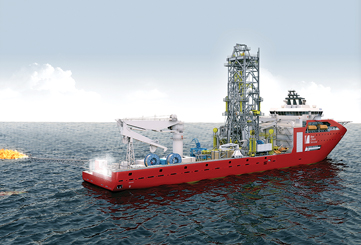Per Wiggo Richardsen, Det Norsk Veritas Maritime
Demand has pushed operators of well intervention units to develop new technologies to improve access to subsea wells, creating a need for more efficient subsea well intervention systems, including riserless light well intervention (RLWI) units. While not appropriate for deep water, RLWI units are optimal for repair, scale removal, installation and manipulation of some equipment (such as valves, plugs and screens), re-perforations, zone isolation, fluid sampling, production logging, chemical treatment and well abandonment, among other services.
In the past, this work was performed by mammoth, slow-moving semisubmersible drilling rigs. However, developments in dynamic positioning systems, ROVs and other specialized onboard systems have allowed well intervention equipment to be placed on monohull units, which can move quickly from one well to the next, helping to reduce chartering costs and improving well recovery rates by up to 50%. Riser well intervention units are still preferred for some kinds of work and in depths greater than 500 m, but new composites now being developed for wireline may soon allow RLWI units to work in deeper waters.
A VESSEL OR AN OFFSHORE UNIT?
Seawell, the first monohull well intervention unit, was built in 1986 by Well-
Ops. The concept proved a success, and, over the next 10 years, demand for LWI units grew. However, because these units are often similar in design to offshore supply, support or multi-purpose vessels, there was uncertainty on how to class them: Are they vessels or mobile offshore units?
Based on its extensive experience in the North Sea offshore industry (home to about 40% of the world’s subsea wells) and other regions, DNV sought to quickly manage these issues. “Based on our experience, technical research and feedback from the industry, we concluded that if the unit is capable of taking control of subsea equipment, such as opening or closing valves on a producing well, it would be classed as offshore, not maritime,” said Per Jahre Nilsen, DNV’s business development manager for well intervention.
Nilsen says that these criteria are consistent with the way many national authorities differentiate between offshore operation and maritime ship/vessel operation and notes that code compliance of mobile offshore development units applies to the offshore classification. Once developed, the new rules were then submitted to external hearings for review and additional comments were solicited from owners and operators.
UNIQUE OFFERING
Today, DNV is the only class society offering the well intervention unit class notation. Nilsen says that defining the parameters of a mandatory class notation for well intervention units required an exhaustive review of different technical elements and a broad range of safety principles that covered ventilation, area classification, shutdown and gas detection, escape, evacuation and communication. The organization sourced in-house expertise on structural design, which took into account substructure and foundations for well intervention equipment and drill floors when applicable. Other issues included fire protection, dynamic positioning and a number of supplementary requirements ranging from gas treatment in the event of a leakage to rescue ladders in the moonpool.
DNV released a new, optional notation called “Well” in October 2009. Nilsen explains that the scope of the Well class notation includes design verification of the well intervention equipment and systems, survey and follow-up during fabrication. Once completed or certified, the equipment will follow traditional classification principles and be inspected on a regular basis.
“By introducing the new voluntary Well class notation together with the revised and mandatory well intervention unit notation, DNV was able to offer owners and operators of well intervention units the same options that owners of drilling units have had in the past,” Nilsen said. “We believe the Well class notation will gain recognition as a mark of quality—an assurance to charterers that the vessel follows internationally recognized standards for well intervention equipment.”
DNV has issued certification for six well intervention vessels, including four optional well notations, for a number of subsea services companies. While the commercial benefits for owners sailing with the optional Well notation are difficult to measure, some well intervention unit operators are hopeful the notation will not only ensure the safe operation of their vessels, but help their bottom line.
 |
|
Fig. 1. Delivered earlier this year from STX Europe, Skandi Aker is the most recent addition to Aker Oilfield Services’ fleet classed with DNV optional Well notation.
|
|
EARLY ADOPTER
One early adopter of the new DNV rules was Aker Oilfield Services. Alf Kristensen, manager of engineering projects at Aker Oilfield Services, says the company has one well intervention unit classed by DNV—the newbuild Skandi Aker. Skandi Aker is a well intervention unit designed for riser-based intervention. Kristensen says DNV worked to modify the optional Well notation to fit the company’s needs. 
|
THE AUTHORS
|
 |
Per Wiggo Richardsen is Director of Communication of Det Norsk Veritas (DNV) Maritime. He has served in several management positions within DNV for more than 12 years, both at the headquarters in Oslo, Norway, and in Houston, Texas. Before becoming a DNV manager, Mr. Richardsen served as Communication Manager within Norsk Hydro (at that time an oil major and today part of Statoil). He has a master’s degree in computer science. Mr. Richardsen began his career as a research scientist.
|
|




